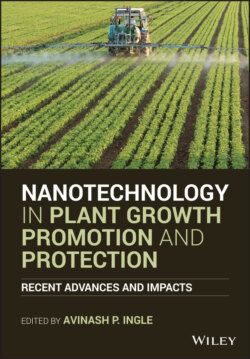Читать книгу Nanotechnology in Plant Growth Promotion and Protection - Группа авторов - Страница 31
1.4 Conclusions
ОглавлениеThe increasing challenges for humanity and food security clearly demonstrate that there is a growing demand for more production with less input in agriculture. One of the main problems in food safety is the application of large quantities of microbial pesticides together with the presence of new microbial‐resistant strains. Also, the increased application of chemical fertilizers. That means the conventional farming practices are not able to control such threats adequately without putting human health at serious risk. Therefore, adoption of modern agricultural techniques and innovative technology is necessary so that such threats can more wisely and precisely controlled. In fact, nanotechnology is among the most advanced scientific methods in the area of agriculture and plant diseases management. Nanotechnology has a leading role in remodeling farming, and in the fight against plant microbes. The research of nanotechnology is already in its premature growth process after recent decades. All the action, however, is very wide and become popular day by day.
The rapid development and implementation of marketable formulations involving artificially designed plant protection nanoparticles has been driven by nanotechnologies in combination with biotechnology. Nanoparticles have proved to be a talented tool in this era to reduce indiscriminate use of unnecessary chemicals and toxins in plants. Specific nanomaterials with high antimicrobial/antiviral potential against pathogens have found to be advantageous and practical, whereas other nanoparticles have a deleterious effect in terms of plant reactivity and phytotoxicity. Therefore, we should be very careful when examining the type of nanomaterial needed for their implementation considering the concentration, physical, chemical, and accumulation properties. Otherwise, they could be a potential serious threat to the entire ecosystem. The effect of nanoparticles depends on several factors, and if their conditions vary, their results can easily and completely change. These factors mainly include type and concentration of the nanomaterials used, the chemical/biological surface coating agent, the age and type of the plant, and the target portion of tissue. Nanobiotechnological industries are now growing very quickly, and new nanofertilizers and antimicrobial nano‐based systems have been developed, but a long way to go to manufacture comparatively cost‐effective, safe, and environmentally friendly and stabilized nanomaterials; however, further extensive studies are also required on these issues. Moreover, it is important to make a broad‐based assessment of these nanomaterials within the food and agri‐food industry to gain public acceptance. In this way, the unlike challenges which faced genetically modified organisms worldwide will be avoided.
The unique impact of nanotechnology and its applications in the agricultural sector is only at its infancy, but the anticipations of this science are still very high in terms of eradicating challenges related to plant disease control, food production, environmental sustainability, and even fossil fuels.
